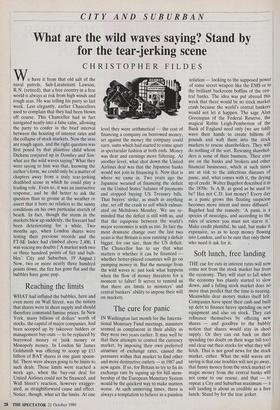The cure for panic
IN Washington last month for the Interna- tional Monetary Fund meetings, ministers seemed as complacent in their ability as they were two years earlier. It may well be that their attempts to control the currency market, by imposing their own preferred structure of exchange rates, caused the pressures within that market to find other and more destructive outlets — in 1987 and now again. If so, for Britain to try to fix its exchange rate by signing up for full mem- bership of the European Monetary System would be the quickest way to make matters worse. At such unnerving times, there is always a temptation to believe in a painless solution — looking to the supposed power of some secret weapon like the EMS or to the brilliant backroom boffins of the cen- tral banks. The idea was put abroad this week that there would be no stock market crash because the world's central bankers would not let it happen. The sage Alan Greenspan of the Federal Reserve, the magical Robin Leigh-Pemberton of the Bank of England need only (we are told) wave their hands to create billions of pounds and waft them into the stock markets to rescue shareholders. They will do nothing of the sort. Rescuing sharehol- ders is none of their business. Their eyes are on the banks and brokers and other financial businesses, which at such times are at risk to the infectious diseases of panic, and, what comes with it, the drying up of credit. Walter Bagehot described it in the 1870s: 'Is A.B. as good as he used to be? Has not C.D. lost money? Every day as a panic grows this floating suspicion becomes more intent and more diffused.' Bagehot had the remedy: 'A panic is a species of neuralgia, and according to the rules of science you must not starve it.' Make credit plentiful, he said, but make it expensive, so as to keep money flowing into London, and to be sure that only those who need it ask for it.


























































 Previous page
Previous page